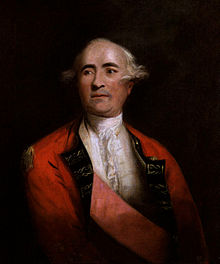Frederick Haldimand
| Sir Frederick Haldimand | |
|---|---|

Portrait by Joshua Reynolds
|
|
|
Governor of Quebec |
|
|
In office 1778–1786 |
|
| Monarch | George III |
| Preceded by | Guy Carleton |
| Succeeded by | Guy Carleton |
| Personal details | |
| Born |
August 11, 1718 Yverdon, Switzerland |
| Died | June 5, 1791 (aged 72) Yverdon, Switzerland |
| Profession | soldier, army officer, provincial governor |
| Military service | |
| Allegiance |
|
| Years of service | 1740–1786 |
| Rank | Lieutenant General |
| Commands | Military governor of Trois-Rivières, Quebec Military command of East and West Florida acting Commander-in-Chief, North America Colonel commandant, 60th Foot |
| Battles/wars |
War of the Austrian Succession |
War of the Austrian Succession
Sir Frederick Haldimand, KB (August 11, 1718 – June 5, 1791) was a military officer best known for his service in the British Army in North America during the Seven Years' War and the American Revolutionary War. From 1778 to 1786, he served as Governor of the Province of Quebec, during which time he oversaw military operations against the northern frontiers in the war, and engaged in ultimately fruitless negotiations to establish the independent Vermont Republic as a new British province. His administration of Quebec was at times harsh, with the detention of numerous political dissidents and agitators.
Haldimand was born in Yverdon, Switzerland. Baptized François-Louis-Frédéric Haldimand, he was the son of a civil servant. He became interested in the military at an early age, and the poor prospects for advancement in Switzerland led him to join foreign armies.
His first service appears to have been in the army of Prussia during the War of the Austrian Succession, with whom he fought at Mollwitz and probably also at Hohenfriedberg and Kesselsdorf. He next joined the Swiss Guards of the Dutch Republic, where he rose to the rank of lieutenant colonel. There he formed a friendship with Henry Bouquet, another Swiss military man, with whom he would serve in North America.
In 1755, as the Seven Years' War (whose North American theater is also known as the French and Indian War) was in its early stages, Haldimand and Bouquet joined a British regiment composed of German and Swiss men recruited at first from the armies of Europe, but then also from German-speaking settlers in North America. Formation of the regiment, known as the Royal American, took two years, and was beset by culture clashes with the rest of the British Army. In spite of this, Haldimand and Bouquet both earned the respect of the British military establishment with their dedicated professionalism. While Haldimand's battalion was sent to Louisbourg in 1758, Haldimand himself served under General James Abercrombie at the disastrous Battle of Carillon, where he suffered minor wounds. After spending the winter in command of the forward British position at Fort Edward, he was made second in command on the 1759 expedition of John Prideaux against Fort Niagara; he was placed in charge of the key supply and communication point at Oswego, New York, where he oversaw the construction of Fort Ontario. When Prideaux was killed early during the Battle of Fort Niagara, Haldimand went to assume command of the operation, but William Johnson, the Indian agent on the expedition who took over, refused to relinquish control. Haldimand returned to Oswego, where he remained throughout the winter. In 1760 he joined General Jeffrey Amherst's army as it descended the Saint Lawrence River, and was the officer who formally took control of Montreal on September 8 following the French surrender. He was given the responsibility for working with the outgoing French leadership as they prepared to depart for France, serving first under Amherst and then under General Thomas Gage.In 1762, Amherst promoted him to colonel, and temporarily gave him the military governorship of Trois-Rivières while its governor, Ralph Burton, was called to serve in the Caribbean. At Trois-Rivières he oversaw the development of the ironworks at nearby Saint Maurice, and arranged for his nephew (also named Frederick) to serve under James Murray, then the military governor of Quebec City.
...
Wikipedia
